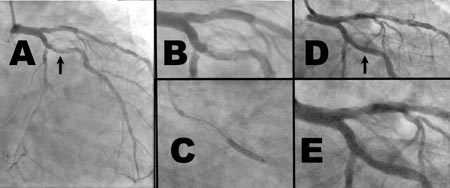
Suspected Clopidogrel Resistance in Patient with Recurrent Coronary Stent Thrombosis
Abstract
Despite aggressive antiplatelet therapy in the setting of percutaneous coronary intervention, the incidence of stent thrombosis remains approximately 0.5% to 0.8%. We report on a 53-year-old male patient with recurrent coronary stent thrombosis treated by coronary re-interventions and anticoagulation. Initial diagnostic selective coronary angiography revealed 90% proximal circumflex coronary artery stenosis in a patient with 3rd degree of stabile angina by Canadian Cardiology Society classification. After premedication with a loading dose of 600 mg clopidogrel, 300 mg aspirin and intravenous enoxaparine 1 mg/kg, a bare-metal stent was implanted. The initial postprocedural course was normal. On the third day after the intervention, the patient was subjected to reintervention because of the stent thrombosis, and on the fifth day after reintervention – to the third percutaneous coronary angioplasty, also because of the stent thrombosis. Clopidogrel resistence was suspected and treatment with warfarin was initiated, after which there were no new cardiac events. Three months later, anticoagulation was discontinued, and as an antiplatelet agent aspirin 100 mg daily remained in therapy. Up to now (one-year), follow-up of the patient has been uneventful. In the case of suspected clopidogrel resistance, alternative therapeutic options have to be considered, like introducing per os anticoagulation (e.g. warfarin), introducing ticlopidin instead of clopidogrel, or, in the near future, possibly introducing prasugrel, a similar agent currently in transition from investigation into clinical use.
Keywords
stent; coronary disease; clopidogrel resistance; thrombosis
DOI: 10.5457/ams.v39i1.108
